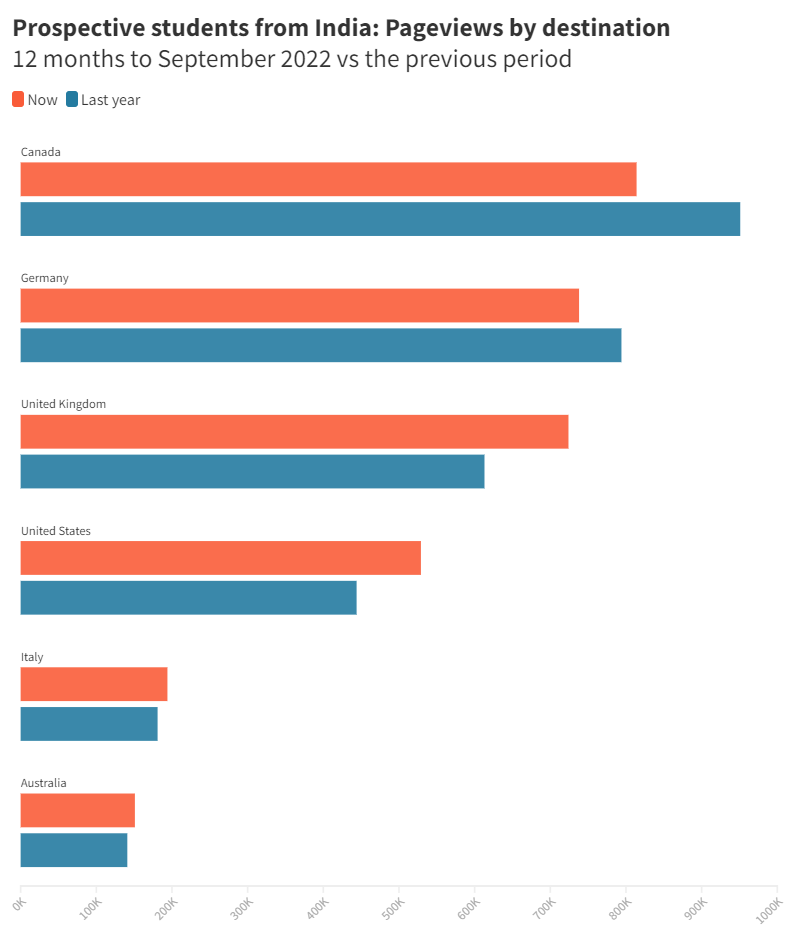Canada losing market share of students from India
Improved safety measures, student-friendly immigration policies and vaccine rollouts have given a boost to plans of Indian students wanting to study abroad.
As per data from the Indian government, more than 1.3 million Indian students are currently pursuing higher education overseas and this figure is expected to grow further over the next few years. Traditionally, more Indian students have opted for the US, the UK, Australia and Canada for higher studies with each of these vying for the top spot when it comes to hosting Indian students.
While there was a 14.4% drop in page views for Canada in the year to September 2022, the UK gained 18% in the same period.

Why Canada Is Losing Market Share
According to official data from the Canadian government, Indian students accounted for 34% of the international student population in 2020. That is approximately 180,380 students out of the total 530,540 international students in the country at all levels of study.
Some of the challenges faced by students include several provinces increasing the international undergraduate tuition fees by an average of nearly 5% in 2021-22. This increase also meant international students have to pay almost three times what Canadian students pay.
“I would argue the macroeconomic factors are probably the most impactful in this sort of decision making, and Canada is also becoming more expensive as the years go by.”
– José Juan González Ortiz, Studyportals Partnership Success Manager
Other reasons include strict travel restrictions in recent months, including a ban on direct flights, which has caused many Indian students to have a difficult experience reaching Canada. Many had to travel via other countries which had their own travel regulations. Additionally, a large amount of students had to re-apply and reappear for visas and medical examinations as their visas had expired during the pandemic. According the The PIE, Delayed visas and a lack of clarity on Immigration rules also affected the plans of students.
The visa application process has become so dire that reports of 1.5 million temporary residence applications are in backlog. (This number is as of June 29th, 2022.) This is almost double the amount of volume from October 2021.
Recently, Canada introduced the Student Direct Stream, a quick method for student visa applications, including those from India and China. However, this method introduced more arduous requirements, such as a high English score. Together, these factors have impacted the attractiveness of destination Canada for students from India.
Why The UK Is Gaining Interest
This growth in interest among Indian students for studying in the UK and the shift away from Canada can be attributed to various factors. According to Ashley Fitchette, Vice President – Global Partnerships at Studyportals, until a few months ago, the attraction to Canada was, and still is, the ease of post-study work visas and permanent residency. “In India, immigration opportunities are an influential part of the decision to study,” she says.
“Prior to the UK suspending the post-study work permit (PSWP), major communities like Punjab, Gujarat and Hyderabad were highly UK-focused markets. This is in part because the UK is closer to India and easier for the students to travel back and forth for religious festivals, holidays etc and because the UK was seen as a desirable place to immigrate post studying”, says Fitchette.
“When the post-study work permit was reinstated, we saw an almost immediate shift of interest back to the UK”
-Ashley Fitchette, Vice President – Global Partnerships at Studyportals
The Graduate route, launched in 2021, allows eligible students to stay in the UK to work, or to search for work up to two years after they have received their degree.
Students who complete their Bachelor’s or Master’s are eligible to apply for a two-year visa without any restrictions, such as a minimum salary or sponsorship by an employer. This period will enable students to get valuable work experience and allow them to transition to the skilled worker visas.
The UK promises world-class education and globally-renowned and reputed universities which attract international students. In addition, the response of the UK to the challenges during the pandemic (including financial assistance, visa flexibility, and other means of support to international students) suggests that more students will be looking to travel to the UK for higher education.
With a focus on student safety, flexibility and the choice to start or resume studies have been other factors which have pulled students to the country.
Measures, such as giving student hardship funding and launching immigration flexibility for students who are unable to fulfill immigration requirements due to the pandemic, have also had an impact.
The UK’s International Education Strategy for 2030 further outlines the importance of Indian students in UK universities, with the UK higher education sector planning to reduce its over-reliance on the Chinese market. Although more Chinese students study in the UK at the Bachelor’s level, a majority of Indian students choose to pursue their Master’s degrees from British universities. T
A strong correlation between Studyportals data and enrolments 12-24 months into the future, has been established time and time again. The correlation with actual enrolment into university programmes has been verified by Studyportals‘ Analytics team, with information coming from EP-NUFFIC, UNESCO, OECD, and HESA datasets. 12 to 24 months is not an arbitrary timeframe – it is the average length of the student journey across our platforms. This data then is a good indication of trends set to impact student enrolments over the next two years.
This article was written by Gauri Kohli, a Senior journalist based in New Delhi, India, with Cara Skikne and Cara Lambregts.
For more updates, follow us!




